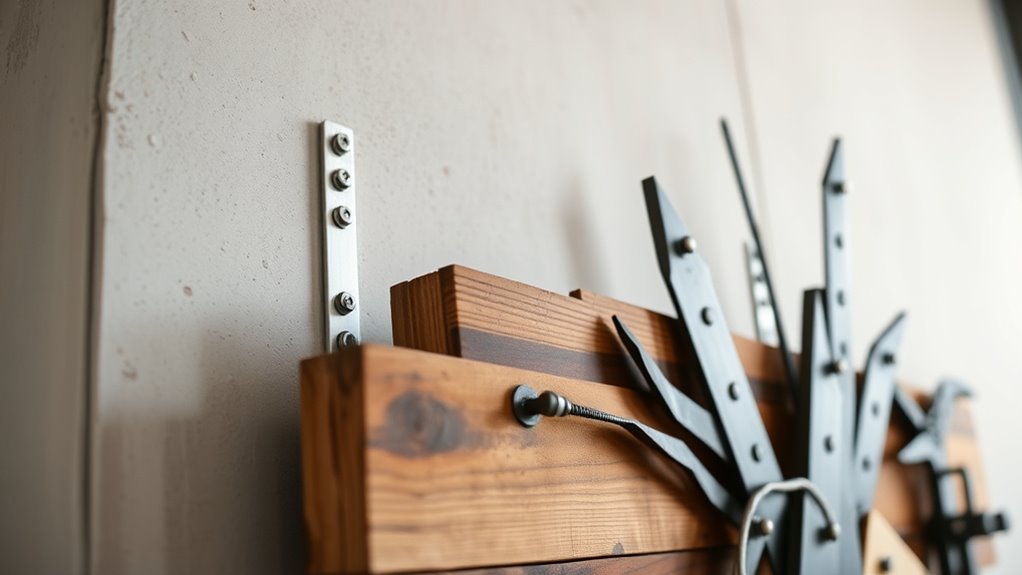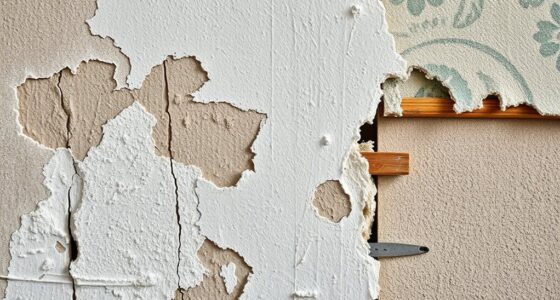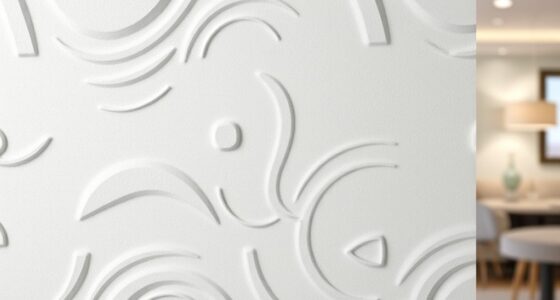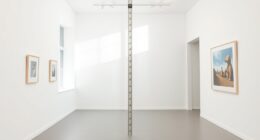To safely install heavy artwork with French cleats, choose a cleat rated for your piece’s weight and make certain it’s properly supported by wall studs or heavy-duty anchors. Double-check that the cleat is level and securely fastened with corrosion-resistant screws, attaching it at multiple points for stability. Make sure the artwork is mounted correctly on the cleat and clicks firmly into place. Proper installation not only protects your art but also keeps your wall safe—learn more about each step to ensure perfect hanging.
Key Takeaways
- Use cleats rated for the weight of your heavy artwork, ensuring they have appropriate weight capacity and distribution design.
- Secure the cleat into wall studs or use heavy-duty anchors to provide maximum support.
- Pre-drill holes and attach the cleat at multiple points with corrosion-resistant screws for stability.
- Mount the artwork’s backing piece level and centered, then carefully hook it onto the wall cleat, ensuring it clicks securely.
- Regularly inspect the installation, verify the cleat’s stability, and re-secure if necessary for ongoing safety.

When hanging heavy artwork, choosing the right mounting system is vital for safety and stability. French cleats are an excellent choice because they distribute weight evenly and provide a secure hold. To guarantee your artwork stays safe, you need to pay close attention to the weight capacity of your chosen cleats. Not all cleats are created equal, so selecting one rated for the weight of your piece is essential. Check the specifications carefully, and don’t underestimate the weight—adding a little extra capacity can provide peace of mind. Proper installation is equally important, and following specific tips can help you avoid accidents or damage to your wall.
First, always locate the wall studs before installing your French cleat. Wall studs offer the best support for heavy objects, so use a stud finder to identify their positions. Anchoring your cleat into studs rather than drywall alone greatly increases the weight capacity. If you can’t align the cleat with a stud, use heavy-duty wall anchors designed for supporting significant weight. Additionally, guarantee the cleat is level; an uneven installation can cause stress points that might lead to failure over time. Use a level to double-check your work and make adjustments before securing everything permanently.
Locate wall studs and use heavy-duty anchors for secure, level French cleat installation.
When attaching the cleat to the wall, pre-drill holes to avoid splitting the wood or damaging the wall surface. This also makes driving screws easier and more precise. Use high-quality, corrosion-resistant screws that are long enough to penetrate into the stud or anchor securely. For extra stability, attach the cleat at multiple points along its length, not just at the ends. This distributes the load more evenly and reduces the risk of tilting or slipping. Remember, the cleat’s orientation matters—install the bevel side facing upward so that the artwork can hook securely onto the wall-mounted piece.
Once the wall-mounted cleat is secure, attach the corresponding piece to the back of your artwork. Make sure this piece is mounted level and centered to prevent uneven hanging. When you hang the artwork, lift it carefully and hook it onto the cleat, ensuring it clicks into place firmly. Regularly check the cleat’s stability and weight capacity, especially if you move or adjust the artwork over time. By following these installation tips and guaranteeing your French cleats are rated for the weight, you can confidently hang heavy art pieces without worry. Proper setup guarantees safety, preserves your artwork, and keeps your walls intact. Additionally, understanding the weight distribution of your art helps ensure that your wall supports the load effectively over time.
Frequently Asked Questions
Can French Cleats Support Outdoor Heavy Art Installations?
Yes, French cleats can support outdoor heavy art installations if you choose weather-resistant materials like treated wood or metal. Make certain the cleats are properly anchored to sturdy, durable surfaces, and regularly check for signs of wear or corrosion. By selecting the right weather-resistant materials and installing them securely, you can confidently display heavy outdoor art without worrying about damage from the elements or structural failure.
What Tools Are Needed for Installing French Cleats?
Did you know that using the right tools can increase installation strength by over 50%? To install French cleats, you’ll need a drill with the appropriate drill bits, a level tool to ensure perfect alignment, a measuring tape, and anchors for secure mounting. These tools help you achieve a safe, precise installation, especially for heavy art. Make sure to double-check your measurements and level to prevent any mishaps.
How to Hide French Cleat Hardware for a Seamless Look?
To hide French cleat hardware for a seamless look, you should opt for concealed mounting options like paintable covers or decorative molding that blend with your wall. Use aesthetic concealment techniques such as wall paint or wallpaper to hide the hardware, ensuring the cleat remains hidden behind the art. Carefully install the cleat so it’s flush against the wall, making the hardware invisible and maintaining a clean, professional appearance.
Are French Cleats Suitable for Uneven Wall Surfaces?
Like a skilled sailor steering through choppy waters, you can use French cleats on uneven wall surfaces by choosing adhesive alternatives or shimming for stability. While traditional cleats work best on smooth walls, you can adapt by installing additional supports or using specialized mounting hardware to compensate for wall surface irregularities. This approach guarantees your heavy art stays secure, even when the wall isn’t perfectly flat, giving you peace of mind and a professional finish.
What Is the Maximum Weight Capacity of Standard French Cleats?
Standard French cleats typically support a weight capacity of up to 100 pounds, but this can vary based on materials and installation. Always check the load limits specified by the manufacturer to verify safe use. If you’re hanging heavy art or objects, consider using heavy-duty cleats or additional support to distribute the weight more effectively, preventing damage or accidents. Proper installation is key to maximizing their load capacity safely.
Conclusion
By choosing the right French cleats and installing them with care, you create a foundation that gently supports your heavy artwork’s presence. When you pay attention to detail and prioritize safety, you guarantee your art remains beautifully displayed for years to come. A thoughtful approach not only safeguards your pieces but also nurtures a sense of quiet confidence in your space. In doing so, you cultivate an environment where your art can quietly thrive and inspire.








